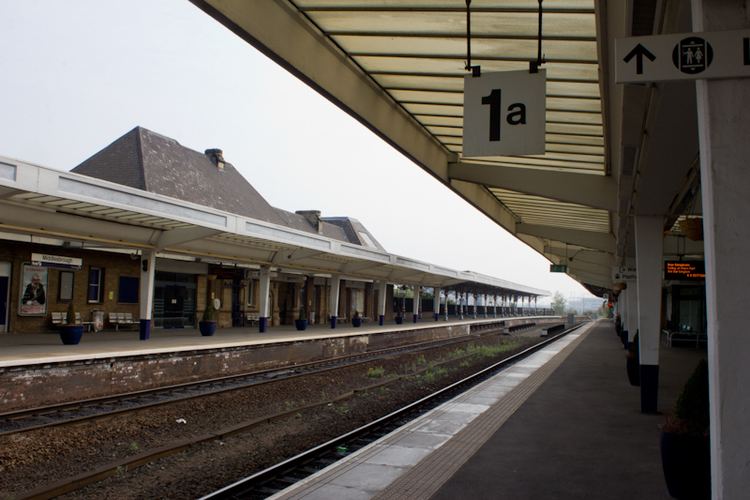Station code MBR 2011/12 1.423 million Opened December 1877 Number of platforms 2 | Grid reference NZ495207 DfT category C1 2012/13 1.364 million | |
 | ||
Address Middlesbrough TS1 1EG, United Kingdom Similar Saltburn railway station, Longbeck railway station, Redcar East railway st, Bishop Auckland railway st, Redcar Central railway st | ||
Middlesbrough railway station
Middlesbrough railway station serves the large town of Middlesbrough in North Yorkshire, England and is managed by TransPennine Express.
Contents
The main station layout consists of an entrance hall with ticket office, large concourse/waiting area and two covered platforms that are each subdivided into two sections i.e. platform 1 (1a and 1b) and platform 2 (2a and 2b). The station is staffed and has a range of facilities including car parking, cafe, newsagent, cycle storage, lifts etc.
Two freight lines bypass to the north of the station.
According to the Office of Rail and Road statistics, Middlesbrough railway station is the fourth busiest in the North East region, with 1,331,452 total entries and exits (2015-16 period).
The bombing of middlesbrough railway station
History
The first railway was built in the area as long ago as 1830 as an extension of the Stockton and Darlington Railway to connect with the port of the then new town of Middlesbrough. A branch off this, passing just south of the new town and extending eastwards to Redcar was opened in June 1846 by the Middlesbrough and Redcar Railway Company.
Situated on the southern edge of the new town on the Redcar branch line, Middlesbrough's first passenger station was designed by John Middleton and opened on 26 July 1847. As the town expanded rapidly during the second half of the 19th Century however, the station was unable to cope with the traffic growth. Due to the design of the station not lending itself to enlargement it was therefore demolished in 1874 and replaced by the current station, opened in December 1877.
The current station was designed by the North Eastern Railway's chief architect, William Peachey, with an ornate Gothic style frontage. Behind this an overall roof of elliptical design once existed. Constructed out of wrought iron of lattice design, with glass covering the middle half and timber (inside)/slate (outside) covering the outer quarters. The two end screens were glazed with timber cladding around the outer edges. The roof was high in relation to its width.
The elliptical roof was severely damaged in a German daylight air raid in the afternoon of 3 August 1942 and eventually removed in 1954, to be replaced by the current design over the concourse and platforms.
A £2.7 million refurbishment of the station is due to start in spring 2017. In a 13-month project, Network Rail will repair the station’s roof and stonework as part of a proposed wider regeneration of the surrounding area.
Services
The station is served by a number of routes, all of which are operated by Northern, except those to Manchester that are operated by TransPennine Express.
The Tees Valley Line from Bishop Auckland & Darlington to Saltburn, (usually a British Rail Class 142 Pacer). Monday to Saturday daytimes there is a service every 30 minutes to Darlington & Saltburn and every second hour to Bishop Auckland. There are also two a.m peak services to Newcastle via Durham. Sundays see an hourly service to Darlington/Saltburn and a two-hourly service to Bishop Auckland.
The Esk Valley Line to Whitby via Nunthorpe and Grosmont, (usually a British Rail Class 156 Super Sprinter or Class 142 Pacer). The hourly service runs up to seventeen trains a day to Nunthorpe with four of the trains continuing to the terminus at Whitby. Sunday services (four each way, some running through to/from Darlington or Newcastle) operate during the spring/summer timetable period from late March until early November. A new station on the Esk Valley Line to serve the James Cook University Hospital (between Middlesbrough and Marton railway stations) was opened on 18 May 2014.
The Durham Coast Line to Newcastle Central via Hartlepool and Sunderland (usually a Class 142 Pacer). There is a train every hour to Newcastle (some of which continue along the Tyne Valley Line). Sundays see an hourly service through to/from the MetroCentre.
The North Trans-Pennine line to Manchester Airport via York and Leeds (using a British Rail Class 185 Pennine Desiro). Monday to Saturdays there is an hourly service to Manchester Airport and every two hours on Sundays. TransPennine Express also operate one daily return service to Liverpool.
On 27 November 2014, it was announced that as part of the new Virgin Trains East Coast franchise, direct rail services from Middlesbrough to London will be re-introduced. In May 2016, the Office of Rail and Road (ORR) approved the application from Virgin Trains East Coast and FirstGroup to provide new train services on the East Coast Main Line, with a start date of 2021 being announced for the Middlesbrough to London service.
Also, under the new Northern franchise awarded to Arriva Rail North in December 2015 (commenced 1 April 2016), service frequencies on several routes are to be improved and rolling stock upgraded.
